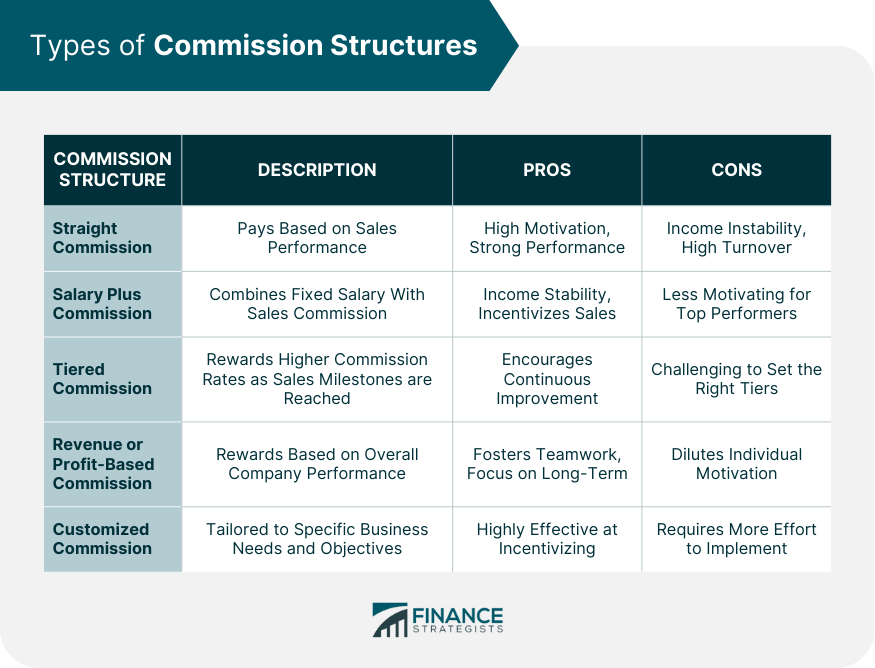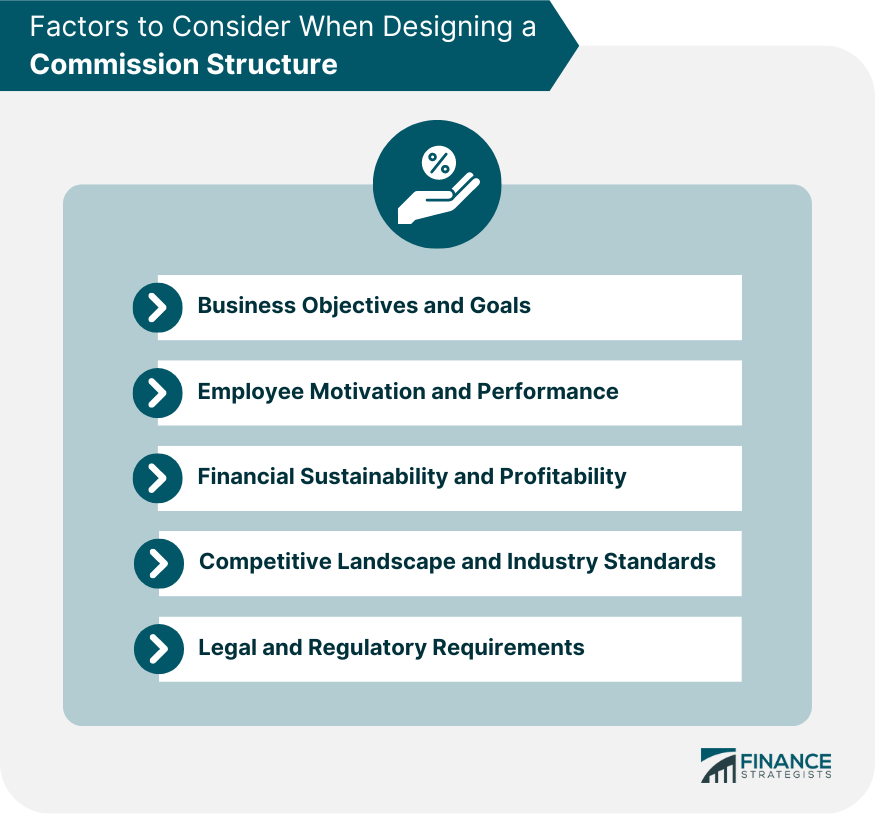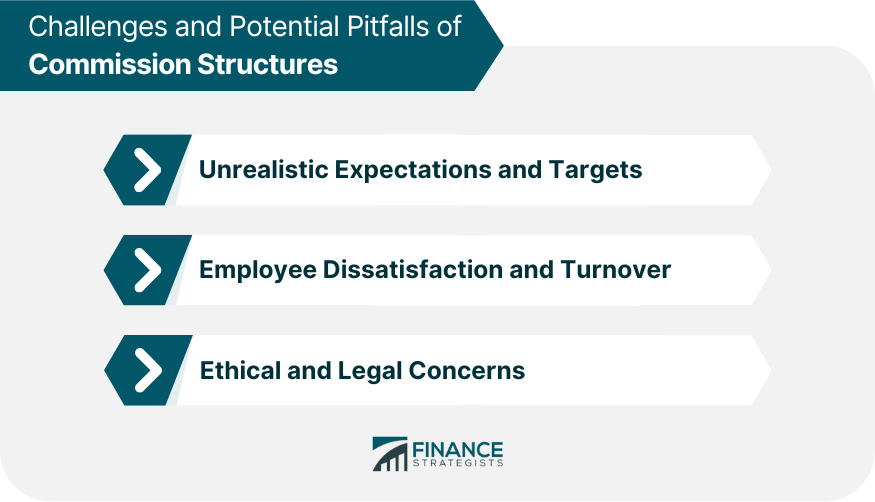Commission structure refers to the system used by companies to compensate salespeople or other types of agents based on the sales they generate. This structure determines the percentage or flat fee that salespeople receive from each sale they make. For example, a company may offer a 10% commission rate for every product sold. This means that if a salesperson sells a product for $1,000, they will receive a commission of $100. Commission structures can vary widely depending on the industry, type of product or service, and the goals of the company. Some companies may offer tiered commission structures, where the percentage of commission increases as the salesperson reaches certain sales targets. Others may offer a flat commission rate for all sales, regardless of the salesperson's performance. Commission structures can be motivating for salespeople since they provide an incentive to make more sales and increase revenue for the company. However, they can also create competition and potentially lead to unethical behavior if salespeople prioritize their commission over the customer's needs or the company's integrity. Straight commission is a compensation model that pays employees based on their individual sales performance. This approach can lead to high motivation and strong sales performance but may also result in income instability and high employee turnover. Salary plus commission combines a fixed salary with a commission based on sales. This structure provides employees with income stability while still incentivizing performance and can help retain talent, but it may be less motivating for top performers compared to a straight commission model. Tiered commission rewards employees with higher commission rates as they reach specific sales milestones. This model can encourage continuous improvement and drive high performance, but setting the right tiers and targets may be challenging. Revenue or profit-based commission structures reward employees based on the company's overall financial performance. This approach can foster teamwork and a focus on long-term goals, but it may dilute individual motivation and accountability. Customized commission structures are tailored to specific business needs and objectives. These structures can be highly effective at incentivizing desired behaviors but may require more effort to design, implement, and maintain. When creating a commission structure, align it with the company's overall goals and objectives. This ensures that the structure supports the desired business outcomes and incentivizes behaviors that drive success. Understanding what motivates employees is key to designing an effective commission structure. A well-designed structure should encourage high performance, reward top performers, and provide opportunities for growth and development. The commission structure should be financially sustainable for the business while still providing attractive incentives for employees. Balancing these factors is crucial to ensure long-term success and profitability. When designing a commission structure, consider the competitive landscape and industry standards. This helps ensure that the structure is attractive to potential hires and retains top talent while remaining cost-effective. It's essential to be aware of any legal and regulatory requirements that may apply to commission structures in your industry. This can help avoid potential legal issues and ensure compliance with relevant laws and regulations. Clear communication and transparency are crucial when implementing a commission structure. Ensuring that employees understand how the structure works, the expectations, and the potential rewards can help foster buy-in and trust. Providing training and support for employees as they adapt to a new commission structure is essential. This can help ensure that employees are equipped to succeed and understand the behaviors and actions that will lead to higher rewards. Regularly monitoring and evaluating the commission structure's effectiveness is crucial for ongoing success. This can help identify any issues or areas for improvement and make adjustments as needed. Setting unrealistic expectations and targets can lead to employee frustration, disengagement, and high turnover. It is important to balance ambition with attainability to ensure employees remain motivated and committed to achieving their goals. Poorly designed commission structures can lead to employee dissatisfaction and high turnover rates. This can be detrimental to the overall success of the business and negatively impact company culture. Regularly reviewing and adjusting the commission structure can help mitigate these risks. In some cases, commission structures can create ethical or legal issues, such as encouraging aggressive sales tactics or creating pay disparities. Ensuring the commission structure complies with legal requirements and promotes ethical behavior is crucial to maintaining a positive company reputation and avoiding potential legal ramifications. A commission structure is a compensation system used by companies to reward salespeople based on their sales performance. There are various types of commission structures, including straight commission, salary plus commission, tiered commission, revenue or profit-based commission, and customized commission structures. When designing a commission structure, factors to consider include business objectives, employee motivation and performance, financial sustainability, competitive landscape, and legal and regulatory requirements. Implementation requires clear communication and transparency, training and support, and regular monitoring and evaluation. Challenges and potential pitfalls of commission structures include unrealistic expectations and targets, employee dissatisfaction and turnover, and ethical and legal concerns. A well-designed commission structure can motivate salespeople and drive company success, but it requires careful consideration and ongoing evaluation to ensure effectiveness and avoid potential issues.What Is Commission Structure?
Types of Commission Structures
Straight Commission Sales
Salary Plus Commission
Tiered Commission
Revenue or Profit-Based Commission
Customized Commission Structures

Factors to Consider When Designing a Commission Structure
Business Objectives and Goals
Employee Motivation and Performance
Financial Sustainability and Profitability
Competitive Landscape and Industry Standards
Legal and Regulatory Requirements

Implementing a Commission Structure
Communication and Transparency
Training and Support
Monitoring and Evaluation
Challenges and Potential Pitfalls of Commission Structures

Unrealistic Expectations and Targets
Employee Dissatisfaction and Turnover
Ethical and Legal Concerns
Final Thoughts
Commission Structure FAQs
Commission structure is the system used by companies to compensate salespeople or other types of agents based on the sales they generate.
The types of commission structures include straight commission, salary plus commission, tiered commission, revenue or profit-based commission, and customized commission structures.
When designing a commission structure, factors include business objectives and goals, employee motivation and performance, financial sustainability and profitability, competitive landscape and industry standards, and legal and regulatory requirements.
Challenges and potential pitfalls of commission structures include unrealistic expectations and targets, employee dissatisfaction and turnover, and ethical and legal concerns.
Key lessons learned from successful commission structures include the importance of aligning the structure with business goals, understanding employee motivation, and the need for ongoing evaluation and adaptation.
True Tamplin is a published author, public speaker, CEO of UpDigital, and founder of Finance Strategists.
True is a Certified Educator in Personal Finance (CEPF®), author of The Handy Financial Ratios Guide, a member of the Society for Advancing Business Editing and Writing, contributes to his financial education site, Finance Strategists, and has spoken to various financial communities such as the CFA Institute, as well as university students like his Alma mater, Biola University, where he received a bachelor of science in business and data analytics.
To learn more about True, visit his personal website or view his author profiles on Amazon, Nasdaq and Forbes.















